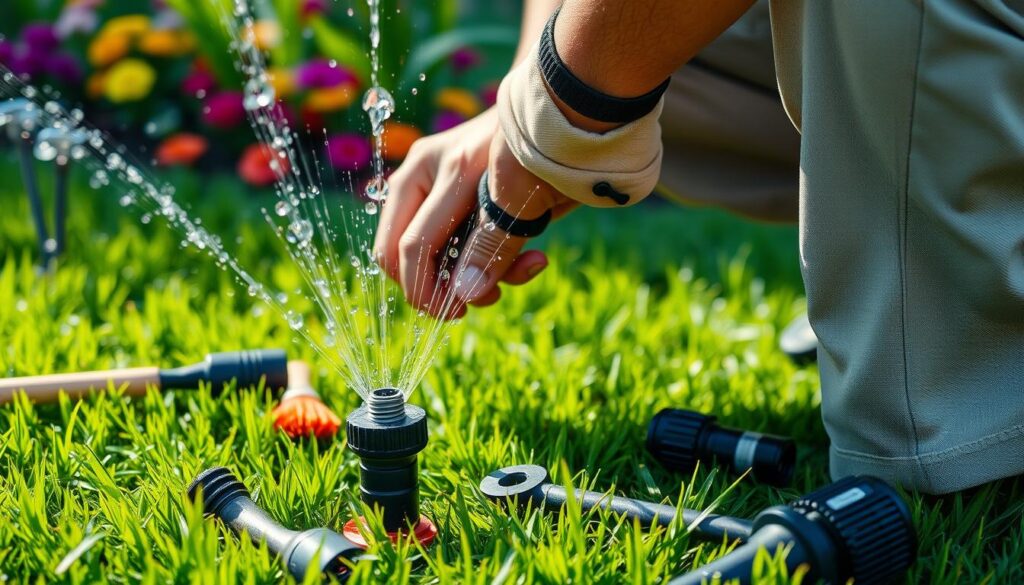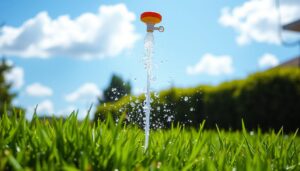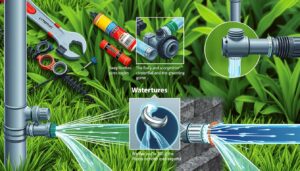A lush, green lawn is a source of pride for many homeowners. In the U.S., 78% of adults have a lawn or landscaping. Yet, 31% are unsure how to keep their yard healthy.
Keeping your sprinkler heads clean is key to a good irrigation system. This guide will show you how to clean sprinklers yourself. We’ll cover effective ways to remove debris and clean filter screens.
By following these tips, you’ll get even water distribution, save on water bills, and make your system last longer. Let’s explore sprinkler head maintenance and improve your lawn care routine!
Understanding Your Lawn Sprinkler System
A well-maintained sprinkler system is key to garden irrigation best practices. Knowing the components of your system helps with sprinkler system upkeep. It ensures a lush, healthy lawn.
Components of a Sprinkler System
Your lawn sprinkler system has several vital parts. These include pipes, water lines, valves, and sprinkler heads. Control valves regulate water flow to different zones in your yard. Back-flow prevention devices near the water meter protect your drinking water from contamination.
Types of Sprinkler Heads
Understanding sprinkler head types is crucial for effective watering. Here’s a breakdown of common types:
- Rotary sprinklers for large turf areas
- Stationary spray heads for smaller spaces
- Pop-up heads that rise when activated
- Drip irrigation for landscape beds
Controllers and Sensors
Modern sprinkler systems use smart controllers and sensors for efficient watering. Controllers manage watering schedules and can be wall-mounted or centrally controlled. Rain sensors, mandated in many states, stop watering when there’s sufficient rainfall.
| Component | Function | Location |
|---|---|---|
| Controller | Manages watering schedule | Garage wall or central system |
| Rain Sensor | Stops watering during rainfall | Exterior of property |
| Control Valves | Regulates water to zones | Random intervals in landscape |
Regular inspection of these components ensures optimal performance and water conservation. By understanding your system, you’re better equipped for sprinkler system upkeep. You can also implement garden irrigation best practices.
The Importance of Clean Sprinkler Heads
Clean sprinkler heads are key to a lush, healthy lawn. Regular care ensures water is spread evenly. This prevents costly problems. Guides on sprinkler maintenance stress the need for clean heads for the best results.
Ignoring your sprinkler heads can cause big issues. Clogged heads lead to uneven water spread. This results in dry spots and wet areas, harming your lawn’s look and raising your water bill.
Experts say to clean your sprinkler heads yearly to avoid clogs. This keeps your lawn green, cuts down on water use, and fights off grass diseases. Look out for signs like low water pressure, uneven water spread, and leaks to know it’s time to clean.
| Benefits of Clean Sprinkler Heads | Consequences of Neglect |
|---|---|
| Even water distribution | Uneven lawn growth |
| Reduced water waste | Higher water bills |
| Improved lawn health | Increased risk of grass diseases |
| Optimal system performance | Reduced system efficiency |
Adjusting water pressure is also vital for sprinkler care. Wrong pressure can waste water and harm your system. By following maintenance guides and keeping heads clean, your lawn stays healthy and your system works well.
Tools Needed for Cleaning Sprinkler Heads
Cleaning sprinkler heads needs the right tools for effective maintenance. Let’s look at the essential tools and optional supplies for easier cleaning.
Essential Tools
To begin cleaning sprinkler heads, you’ll need these basic items:
- Adjustable vice grips
- Needle-nose pliers
- Clean towel
These tools help lift sprinkler tips and remove filters safely. Vice grips give a firm hold, and pliers help with small parts.
Optional Cleaning Supplies
For deep nozzle cleaning, consider these extra items:
- Soft-bristled toothbrush
- Warm water
- Mild dish soap
- Soft cloth
These supplies make cleaning sprinkler heads better. A toothbrush gets rid of tough debris, and soap and water make a gentle solution.
| Tool | Purpose |
|---|---|
| Vice Grips | Secure grip on sprinkler head |
| Needle-nose Pliers | Remove small components |
| Toothbrush | Scrub away debris |
| Dish Soap | Create cleaning solution |
With these tools and supplies, you’re set for effective sprinkler head maintenance. Regular cleaning keeps water flow optimal and extends your irrigation system’s life.
How to Clean Sprinkler Heads: Step-by-Step Guide
Cleaning sprinkler heads is key to lawn care. It keeps your system running smoothly by removing dirt and debris. Here’s how to do it step by step.
Lifting the Sprinkler Tip
Begin by carefully lifting the sprinkler tip. You might need your fingers or pliers. Hold it with vice grips to keep it still while you clean.
Removing the Filter
Next, unscrew the tip to get to the filter. This small part catches dirt and debris, which can mess up the spray.
Cleaning the Components
Wipe the filter clean with a towel. For tough dirt, soak it in a cleaning solution for two minutes. Then, gently brush each screen to remove all debris.
Reassembling the Sprinkler Head
Before putting it all back, turn on the system briefly to flush the line. This gets rid of any dirt left behind. Then, carefully put the sprinkler head back together.
| Step | Action | Purpose |
|---|---|---|
| 1 | Lift sprinkler tip | Access internal components |
| 2 | Remove filter | Expose dirt and debris |
| 3 | Clean components | Remove buildup |
| 4 | Flush line | Clear remaining dirt |
| 5 | Reassemble | Restore functionality |
Regular cleaning of sprinkler heads improves water flow and can make your system last longer. With good care, high-quality sprinkler heads can last up to 10 years.
Dealing with Stubborn Dirt and Debris
Stubborn dirt and debris can be a real pain when cleaning your sprinkler heads. Don’t worry, though! With the right methods, you can tackle even the toughest buildup. Let’s dive into some effective nozzle cleaning techniques and tips for cleaning filter screens.
For those pesky mineral deposits, try soaking the sprinkler head in hot water mixed with a rust remover for about 30 minutes. This solution works wonders on calcium buildup and other minerals from your water supply. After soaking, use a soft brush to scrub away any remaining gunk.
Hard water deposits got you down? A vinegar solution can be your secret weapon. Mix equal parts white vinegar and water, then soak the sprinkler components for an hour. The acidity helps break down stubborn mineral buildup without damaging the delicate parts.
- Use a paperclip to dislodge debris from small openings
- Avoid abrasive materials like steel wool or wire brushes
- Clean sprinkler heads at least twice a year to prevent major clogs
Remember to rinse all parts thoroughly with clean water after cleaning. Don’t forget to lubricate moving parts with a spray like WD40 before reassembling. This step helps prevent future buildup and ensures smooth operation of your sprinkler system.
“Waiting too long between cleanings is one of the most common mistakes homeowners make. Regular maintenance can extend the life of your sprinkler heads up to 15 years!”
By following these nozzle cleaning techniques and dedicating time to cleaning filter screens, you’ll keep your sprinkler system running smoothly for years to come. Remember, a clean sprinkler head means a healthier, greener lawn!
Maintenance Schedule for Sprinkler Systems
Keeping your sprinkler system in good shape is crucial. Regular maintenance ensures your lawn stays green and your water bills stay low. Let’s look at the key tasks you should do all year.
Monthly Inspections
Regular checks are essential to catch small problems early. Take a walk around your lawn to look for:
- Leaks or broken lines
- Misdirected sprinkler heads
- Uneven water distribution
- Clogged nozzles
For dry, pre-action, and deluge systems, check gauges weekly. Control valves also need weekly checks. Wet pipe systems and alarm valves should have monthly gauge inspections.
Seasonal Adjustments
Your lawn’s water needs change with the seasons. Adjust your sprinkler system as follows:
- Summer: Water 3-4 days per week before 10 AM or after 6 PM
- Winter: Water once or twice a week in the morning
- Spring/Fall: Adjust as needed based on rainfall
Cleaning your filters and valves twice a year is recommended. This keeps water flowing well. Don’t forget to have a professional inspect your system periodically for a thorough check.
| Maintenance Task | Frequency |
|---|---|
| Check gauges (dry systems) | Weekly |
| Inspect control valves | Weekly |
| Check wet pipe systems | Monthly |
| Clean filters and valves | Twice yearly |
| Professional inspection | Annually |
By sticking to these maintenance tasks and cleaning schedules, your sprinkler system will stay in great condition all year.
Troubleshooting Common Sprinkler Issues
Dealing with sprinkler problems can be frustrating. But knowing common issues helps keep your lawn healthy. Let’s look at some frequent sprinkler troubles and how to solve them.
Clogged sprinkler heads are a common problem. Dirt and debris can block water flow. Cleaning them regularly is key for good performance.
Misaligned heads are another issue. They might get knocked out of place by lawn mowing or accidental bumps. Adjusting them ensures your lawn gets water evenly.
Leaking pipes can really hurt your system’s efficiency. If you see wet spots or your water bill goes up, check for leaks. Sprinkler maintenance guides can help with small leaks. But big problems might need a pro.
Malfunctioning valves can mess up water distribution. Look for wear and tear, and replace bad valves fast. Electrical issues with the controller can mess up your watering schedule. If your watering is off, check the wiring and settings.
| Issue | Possible Cause | Solution |
|---|---|---|
| Clogged heads | Dirt buildup | Clean filters regularly |
| Misaligned heads | Accidental bumps | Realign manually |
| Leaking pipes | Wear and tear | Repair or replace |
| Faulty valves | Age or damage | Replace valve |
| Controller issues | Wiring problems | Check connections |
While some problems you can fix yourself, others need a pro. Regular maintenance and quick fixes keep your sprinkler system working well. This ensures your lawn stays lush and healthy all year.
Advanced Sprinkler Maintenance Techniques
Keeping your sprinkler system in top shape is more than basic cleaning. Advanced maintenance can greatly improve your lawn’s health and water use. Let’s look at two important methods for sprinkler system upkeep: the tuna can test and adjusting water pressure.
The Tuna Can Test
The tuna can test is a simple yet effective way to check water distribution on your lawn. Here’s how to do it:
- Place empty tuna cans or similar containers around your lawn
- Run your sprinklers for 15 minutes
- Measure the water depth in each can
- If levels are uneven, adjust your sprinkler heads accordingly

Adjusting Water Pressure
Proper water pressure is key for your sprinklers to work well. Too high or too low pressure can cause uneven spraying or misting. Use a pressure gauge to check your system’s pressure and adjust as needed.
| Pressure Level | Effect on Sprinklers | Solution |
|---|---|---|
| Too Low | Weak spray, poor coverage | Install a booster pump |
| Too High | Misting, water waste | Install a pressure reducer |
| Optimal | Even spray, good coverage | Regular maintenance |
By mastering these advanced maintenance techniques, your sprinkler system will work at its best. Regular water pressure adjustments and distribution tests are crucial for effective sprinkler upkeep.
Water Conservation Tips for Sprinkler Systems
Efficient irrigation is key to eco-friendly lawn care. By using smart water conservation techniques, you can keep your yard lush while saving water. Here are some practical tips to make your sprinkler system more eco-friendly.
Timing is everything for water conservation. Water your lawn in the cooler parts of the day, like early morning or late evening. This cuts down on evaporation and lets water soak into the soil better. Lawns usually need only 1 to 1.5 inches of water per week, including rain.
Installing rain sensors can greatly improve your sprinkler system’s efficiency. These devices stop unnecessary watering during or after rain, saving up to 6,300 gallons of water monthly. Also, adjust your watering schedule with the seasons to avoid too much water.
- Use drought-tolerant plants to reduce water use
- Apply mulch to keep soil moisture
- Regularly check for leaks and overspray
- Consider upgrading to WaterSense labeled controllers
Did you know homes with timer-controlled irrigation systems use 50% more water outdoors than those without? To fight this, think about using micro-irrigation devices like drip systems for gardens and shrubs. These systems cut down on evaporation and runoff, making them very efficient.
| Water-Saving Method | Potential Savings |
|---|---|
| High-efficiency nozzles | 16 gallons per nozzle/week |
| Shortening irrigation times | 80 gallons/week (2 min reduction) |
| Fixing leaks | Up to 10,000 gallons/year |
By using these water-saving strategies, you’ll save water and help your lawn grow healthier. Remember, too much water can lead to weed growth, disease, and harmful runoff. With these tips, you’re on your way to a beautiful, sustainable yard.
When to Call a Professional
Doing your own sprinkler maintenance can save money. But, there are times when you need a pro. Knowing when to call a professional can save you from costly mistakes and keep your lawn healthy.
If your water bill suddenly goes up or you see puddles, it’s time to call a pro. These signs often mean hidden leaks or broken pipes. They need special tools and knowledge to fix.
Unusual sounds from your sprinkler or low water pressure are warning signs. These can cause uneven watering and a dry lawn. A pro can fix these problems quickly and efficiently.
- Faulty sprinkler controllers causing inconsistent watering schedules
- Clogged or broken sprinkler heads affecting water flow
- Low water pressure impacting system performance
- Visible damage to pipes or other components
Getting an annual check-up from a pro is a good idea. They can keep your system running well and prevent big problems. They also offer tips on saving water.
Ignoring sprinkler issues can waste water, harm plants, and cost more to fix later. If you’re unsure, it’s best to get professional help. This way, your irrigation system stays in great condition.
Benefits of Regular Sprinkler Head Cleaning
Clean sprinkler heads are crucial for efficient irrigation and lawn health. Regular maintenance of your sprinkler system offers many benefits. Let’s look at the advantages of keeping your sprinkler heads in good shape.
Improved Water Distribution
Clean sprinkler heads ensure your lawn gets water evenly. This prevents dry spots and soggy areas, helping your grass grow well. Regular maintenance of sprinkler systems boosts performance and saves water.
Cost Savings
Properly maintained sprinkler heads save you money. They help you use less water, which lowers your utility bills. Spending $55 to $85 on maintenance can prevent costly repairs later.
Healthier Lawn
Clean sprinkler heads lead to a lush, vibrant lawn. Even water distribution strengthens grass roots and makes your lawn more resilient. This means a healthier lawn that can fight off pests and diseases better.
| Benefit | Impact |
|---|---|
| Water Conservation | Up to 30% reduction in water usage |
| Cost Savings | 15-20% decrease in water bills |
| Lawn Health | 25% improvement in grass density |
The perks of clean sprinkler heads go beyond your lawn. Efficient irrigation systems help save water, making your yard care eco-friendly.
“A well-maintained sprinkler system is an investment in your lawn’s future, providing long-term benefits for both your property and the environment.”
Additional Lawn Care Tips for a Lush Yard
Keeping your lawn beautiful is more than just cleaning sprinkler heads. To get a lush yard, you need to follow many lawn care tips. Start by knowing your grass type and what it needs, as different areas have different needs.
Watering your lawn right is key. Try to give it 1-2 inches of water each week. Water in the early morning or late evening to reduce evaporation. Your lawn might need more water in the hot summer. Think about getting a smart irrigation system to save water and money.
Mowing is also very important. Cut no more than one-third of the grass height at a time. This might mean mowing every 4-5 days when it’s growing fast. For cool-season grasses, fertilize in fall and spring. Warm-season grasses do best with feeding in late spring and summer. Also, aerate your lawn when the soil is moist to help it absorb water better.
Finally, handle weeds wisely. Use weed-and-feed products on dewy mornings for better results. Apply granular herbicides from March to May to control crabgrass and other weeds. By following these tips and keeping your sprinklers in good shape, you’ll have a healthy, beautiful yard that everyone will admire.

I’m Carlos Robert, a passionate gardener, and blogger. With years of experience and knowledge in the field of garden watering, I have created a blog to share my insights and tips on the topic. I strive to provide readers with detailed information about all aspects of sprinkler systems, from garden sprinklers to fire sprinklers, along with nozzles, hoses, and other related products. I love helping my readers create the perfect garden with their ideal setup!


